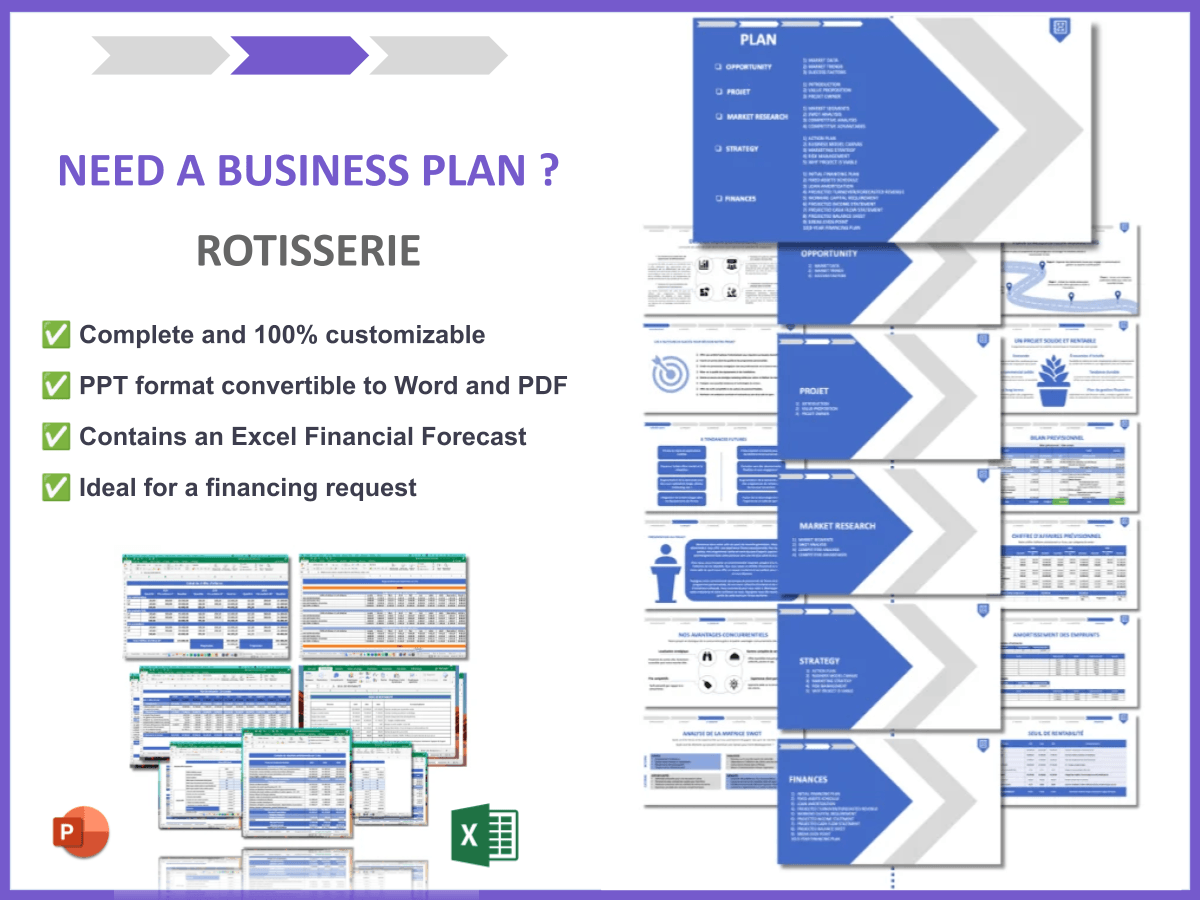Why Should You Have a SWOT Analysis for Your Rotisserie Business?
Did you know that nearly 90% of small businesses fail within the first five years? Shocking, right? If you’re thinking about starting a rotisserie business, you might want to take notes! A SWOT analysis is essential for understanding your business’s strengths, weaknesses, opportunities, and threats. It’s like having a roadmap to navigate the complexities of the food industry.
In a nutshell, a SWOT analysis helps you identify where you stand and where you could go. It’s not just for corporate giants; even small business owners like you can benefit immensely.
Here are 10 reasons why you should consider a SWOT analysis for your rotisserie business:
- Clarifies your business vision
- Identifies competitive advantages
- Helps allocate resources efficiently
- Pinpoints potential risks
- Encourages proactive planning
- Enhances decision-making
- Supports marketing strategies
- Fosters team collaboration
- Informs product development
- Guides long-term growth strategies
How Do You Write a SWOT Analysis for Your Rotisserie Business?
Writing a SWOT analysis isn’t rocket science, but it does require some thought. Let’s break it down.
Strengths
When crafting your SWOT analysis, start with strengths. What makes your rotisserie business unique? Maybe you have a secret recipe or locally sourced ingredients.
Weaknesses
Next, think about weaknesses. Are you lacking in marketing skills? Maybe your location isn’t the best. It’s crucial to be honest here.
Opportunities
Then, consider opportunities. Is there a growing trend for healthy eating? Are there partnerships you could explore?
Threats
Finally, identify threats. What challenges could impact your business? Perhaps rising food costs or increased competition are on the horizon.
SWOT Example N°1 for a Local Rotisserie
Let’s dive into an example.
| SWOT | Analysis |
|---|---|
| Strengths | Unique recipes, quality ingredients |
| Weaknesses | Limited marketing budget |
| Opportunities | Growing demand for organic food |
| Threats | High competition in the area |
- Unique recipes attract a loyal customer base.
- Quality ingredients enhance the brand image.
- Limited marketing could restrict customer reach.
- The organic food movement provides a great opportunity.
- This example showcases the importance of leveraging strengths while being aware of weaknesses. The organic trend is a potential goldmine for growth.
SWOT Example N°2 for a Rotisserie Chain
Here’s another look.
| SWOT | Analysis |
|---|---|
| Strengths | Strong brand recognition |
| Weaknesses | Standardized menu may lack variety |
| Opportunities | Expansion into new markets |
| Threats | Economic downturn affecting consumer spending |
- Strong brand recognition can attract new customers.
- A standardized menu might not appeal to all tastes.
- New markets present exciting growth potential.
- Economic downturns can significantly impact sales.
- This example highlights how brand strength can be a double-edged sword. While recognition is beneficial, menu variety could be a concern.
SWOT Example N°3 for a Gourmet Rotisserie
Next up, let’s consider a gourmet rotisserie.
| SWOT | Analysis |
|---|---|
| Strengths | Gourmet offerings |
| Weaknesses | Higher price point |
| Opportunities | Collaborations with local farms |
| Threats | Economic shifts affecting luxury spending |
- Gourmet offerings can attract a niche market.
- Higher prices may deter budget-conscious customers.
- Collaborations could enhance product quality.
- Economic shifts may reduce luxury spending.
- Here, the gourmet aspect can be a unique selling proposition, but it also presents challenges in terms of pricing.
SWOT Example N°4 for a Family-Owned Rotisserie
Let’s take a look at a family-owned business.
| SWOT | Analysis |
|---|---|
| Strengths | Family recipes |
| Weaknesses | Limited marketing expertise |
| Opportunities | Community involvement |
| Threats | Changing consumer preferences |
- Family recipes create a personal connection.
- Limited marketing could hinder growth.
- Community involvement fosters customer loyalty.
- Changing preferences may require menu adjustments.
- This example emphasizes the emotional connection family recipes can create but also highlights the need for marketing savvy.
SWOT Example N°5 for a Health-Conscious Rotisserie
Now, let’s analyze a health-focused rotisserie.
| SWOT | Analysis |
|---|---|
| Strengths | Healthy menu options |
| Weaknesses | Niche market |
| Opportunities | Growing health trend |
| Threats | Misconceptions about rotisserie food |
- Healthy options can draw health-conscious customers.
- A niche market may limit customer base.
- The health trend offers significant growth potential.
- Misconceptions could deter potential customers.
- This example shows that while a focus on health can be a strength, it can also limit the audience.
SWOT Example N°6 for a Rotisserie Food Truck
Let’s explore a food truck concept.
| SWOT | Analysis |
|---|---|
| Strengths | Mobility and flexibility |
| Weaknesses | Limited menu options |
| Opportunities | Events and festivals |
| Threats | Regulatory challenges |
- Mobility allows for various sales locations.
- Limited menu could turn away customers.
- Events can boost visibility and sales.
- Regulatory hurdles can complicate operations.
- This example illustrates how a food truck can capitalize on mobility but must navigate regulations carefully.
SWOT Example N°7 for a High-End Rotisserie
Now, let’s look at a high-end concept.
| SWOT | Analysis |
|---|---|
| Strengths | Exclusive dining experience |
| Weaknesses | High operating costs |
| Opportunities | Partnerships with local wineries |
| Threats | Economic downturns affecting luxury dining |
- Exclusive experiences attract affluent customers.
- High costs can squeeze profit margins.
- Partnerships can enhance the dining experience.
- Economic shifts may impact luxury spending.
- This example shows how exclusivity can be a draw, but costs are a constant concern.
SWOT Example N°8 for a Rotisserie Franchise
Let’s analyze a franchise model.
| SWOT | Analysis |
|---|---|
| Strengths | Established brand |
| Weaknesses | Franchise fees |
| Opportunities | Franchise expansion |
| Threats | Market saturation |
- Established brands attract franchisees.
- Franchise fees can limit profitability.
- Expansion offers growth potential.
- Market saturation can lead to stiff competition.
- This example highlights the advantages of an established brand, but fees and saturation can be limiting factors.
SWOT Example N°9 for a Rotisserie with a Unique Theme
Now, let’s look at a themed rotisserie.
| SWOT | Analysis |
|---|---|
| Strengths | Unique ambiance |
| Weaknesses | Niche appeal |
| Opportunities | Themed events |
| Threats | Trends changing |
- Unique ambiance can attract a loyal following.
- Niche appeal may limit customer base.
- Themed events could draw crowds.
- Changing trends may require menu adjustments.
- This example emphasizes creativity but warns of the risks of being too niche.
SWOT Example N°10 for a Rotisserie Catering Service
Lastly, let’s explore a catering service.
| SWOT | Analysis |
|---|---|
| Strengths | Versatile menu |
| Weaknesses | Dependence on events |
| Opportunities | Corporate contracts |
| Threats | Seasonal fluctuations |
- Versatile menus can cater to various events.
- Dependence on events can be risky.
- Corporate contracts offer stable income.
- Seasonal fluctuations can impact demand.
- This example shows how versatility can be a strength, but reliance on events can be a double-edged sword.
Conclusion: Summarizing Your Rotisserie SWOT Analysis
In conclusion, creating a Rotisserie SWOT analysis is crucial for understanding your business landscape. Each example demonstrates the diverse strengths, weaknesses, opportunities, and threats that different types of rotisserie businesses face. Utilize this analysis to carve out your unique space in the market and prepare for the challenges ahead.
If you’re serious about launching your rotisserie business, consider checking out this rotisserie business plan template that can help guide you through the process. Additionally, you might find our articles helpful: How To Start a Rotisserie Business? and How To Write a Rotisserie Marketing Plan?.
FAQ
What is a SWOT analysis?
A SWOT analysis is a strategic tool that helps businesses identify their strengths, weaknesses, opportunities, and threats to better understand their position in the market.
Why should I conduct a SWOT analysis for my rotisserie?
Conducting a SWOT analysis helps you clarify your business vision, identify competitive advantages, and understand potential risks, all of which are vital for your rotisserie business success.
How can I improve my rotisserie’s weaknesses identified in a SWOT analysis?
By acknowledging your weaknesses, you can create targeted strategies to address them, such as investing in marketing or enhancing your menu diversity.
What are some common opportunities for rotisserie businesses?
Common opportunities include tapping into health trends, collaborating with local farms, and expanding into new markets.
How do I identify threats to my rotisserie business?
Stay informed about industry trends and competitor actions to identify potential threats such as economic downturns or changing consumer preferences.
Can a SWOT analysis help with marketing strategies?
Yes! A SWOT analysis can inform your marketing strategies by aligning them with your strengths and opportunities while being mindful of weaknesses and threats.
How often should I update my SWOT analysis?
It’s advisable to review and update your SWOT analysis regularly, especially when significant changes occur in your rotisserie business or the market.
What tools can assist in creating a SWOT analysis?
There are various online templates and software available that can help you structure your SWOT analysis effectively.
Is a SWOT analysis only applicable to food businesses?
No, a SWOT analysis can be applied to any business or project, providing valuable insights across different industries.
What should I include in my SWOT analysis?
Focus on internal factors like strengths and weaknesses, as well as external factors such as opportunities and threats that are relevant to your rotisserie business.







